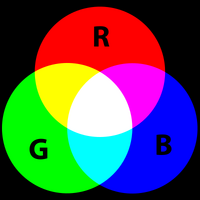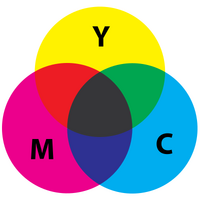Assessment |
Biopsychology |
Comparative |
Cognitive |
Developmental |
Language |
Individual differences |
Personality |
Philosophy |
Social |
Methods |
Statistics |
Clinical |
Educational |
Industrial |
Professional items |
World psychology |
Cognitive Psychology: Attention · Decision making · Learning · Judgement · Memory · Motivation · Perception · Reasoning · Thinking - Cognitive processes Cognition - Outline Index
Biological basis[]
Primary colors are not a fundamental property of light but rather a biological concept, based on the physiological response of the human eye to light. Fundamentally, light is a continuous spectrum of wavelengths, meaning that there are an infinite number of colors. However, the human eye normally contains only three types of color receptors called cones. These respond to specific wavelengths of light. Humans and other species with three such types of color receptors are known as trichromats. Although the peak responsivities of the cones do not occur at the frequencies corresponding to red, green, and blue, those three colors were probably chosen as primary because with them it is possible to almost independently stimulate the three types of color receptors, providing a wide gamut of experiences.
To generate optimal color ranges for species other than humans, other primary colors would have to be used. For example, for species known as tetrachromats, with four different color receptors, one would use four primary colors (since humans can only see to 400 nanometers (violet), but tetrachromats can see into the ultraviolet to about 300 nanometers, this fourth primary color might be located in the shorter-wavelength range and would probably be a pure spectral magenta rather than the magenta we see which is a mixture of red and blue).
Many birds and marsupials are tetrachromats and it has been suggested that some female humans are born as tetrachromats as well[1][2], having an extra receptor for yellow. The peak response of human color receptors varies, even amongst individuals with 'normal' color vision[3]; in non-human species this polymorphic variation is even greater, and it may well be adaptive[4]. Most mammals other than primates have only two types of color receptors and are therefore dichromats; to them, there are only two primary colors.
It would be incorrect to assume that the world 'looks tinted' to an animal (or human) with anything other than the human standard of three color receptors. To an animal (or human) born that way, the world would look normal to it, but the animal's ability to detect and discriminate colors would be different from that of a human with normal color vision.
Additive primaries[]

Additive color mixing
Media that combine emitted lights to create the sensation of a range of colors are using the additive color system. Television is the most common use of this. The additive primaries are red, green, and blue. Because of the response curves of the three different color receptors in the human eye, these colors are optimal in the sense that the largest range of colors — a gamut — visible by humans can be generated by mixing light of these colors. Additive mixing of red and green light produces shades of yellow or orange. Mixing green and blue produces shades of cyan, and mixing red and blue produces shades of purple and magenta. Mixing equal proportions of the additive primaries results in shades of grey; when all three colors are fully saturated, the result is white. The color space that is generated is called the RGB ("red, green, blue") color space.
Subtractive primaries[]
Media that use reflected light and colorants to produce colors are using the subtractive color method of color mixing. In the printing industry, to produce the varying colors, the subtractive primaries yellow, cyan, and magenta are applied together in varying amounts. Subtractive color works best when the surface or paper is white, or close to it.

Subtractive color mixing
Mixing yellow and cyan produces shades of green; mixing yellow with magenta produces shades of red, and mixing magenta with cyan produces shades of blue. In theory, mixing equal amounts of all three pigments should produce shades of grey, resulting in black when all three are fully saturated, but in practice they tend to produce muddy brown colors. For this reason, a fourth "primary" pigment, black, is often used in addition to the cyan, magenta, and yellow colors.
The color space generated is the so-called CMYK color space. The abbreviation stands for "Cyan, Magenta, Yellow, and Black" — the black is referred to as K for key, a shorthand for the printing term "key plate" (the printing plate that impressed the artistic detail of an image, usually in black ink).
In practice, mixtures of actual materials like paint tend to be less precise. Brighter, or more specific colors can be created using natural pigments instead of mixing, and natural properties of pigments can interfere with the mixing. For example, mixing magenta and green in acrylic creates a dark cyan - something which would not happen if the mixing process were perfectly subtractive. In the subtractive model, adding white to a color does not change its hue but does reduce its saturation.
See also[]
- Color theory
- Color vision
- List of colors
- Psychophysics
- Secondary color
- Tertiary color
- Visual perception
Bibliography[]
- ↑ Backhaus, Kliegl & Werner "Color vision, perspectives from different disciplines" (De Gruyter, 1998), pp.115-116, section 5.5.
- ↑ Pr. Mollon (Cambridge university), Pr. Jordan (Newcastle university) "Study of women heterozygote for colour difficiency" (Vision Research, 1993)
- ↑ Neitz, Jay & Jacobs, Gerald H. (1986). "Polymorphism of the long-wavelength cone in normal human colour vision." Nature. 323, 623-625.
- ↑ Jacobs, Gerald H. (1996). "Primate photopigments and primate color vision." PNAS. 93 (2), 577–581.
External links[]
- Ask A Scientist: Primary Colors
- The Color-Sensitive Cones at HyperPhysics
- Handprint.com : do "primary" colors exist? - a comprehensive site on color primaries, color perception, color psychology, color theory, and color mixing
- Color Tutorial
<!- da:Primærfarver de:Grundfarbe el:Βασικά χρώματα es:Color primario eo:Primara koloro fr:Couleur primaire gl:Cor primaria ko:삼원색 id:Warna primer he:צבע יסוד nl:Primaire kleur no:Primærfarge pt:Cor primária simple:Primary color fi:Pääväri sv:Primärfärg th:แม่สี vi:Màu gốc zh-yue:三原色 zh:原色 -->
| This page uses Creative Commons Licensed content from Wikipedia (view authors). |